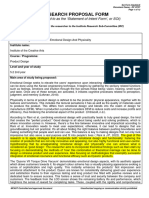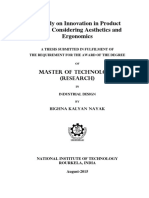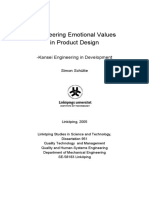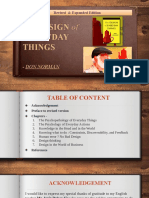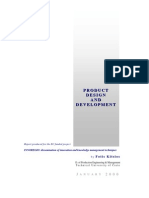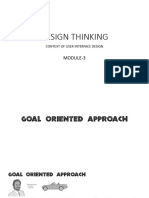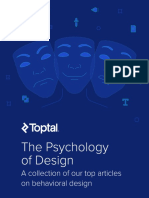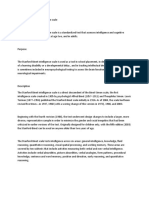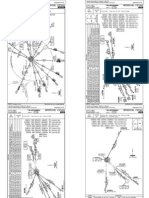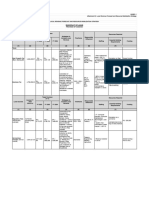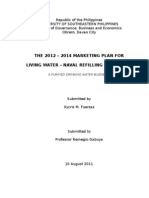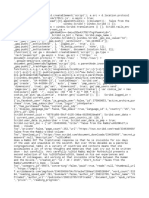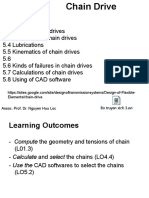748374239.
doc
Document Owner : DP VPET
Page 1 of 13
RESEARCH PROPOSAL FORM
(also referred to as the ‘Statement of Intent Form’, or SOI)
To be submitted by the researcher to the Institute Research Sub-Committee (IRC)
Research Title:
A Product Design balanced with Emotional Design And Physicality
Institute name:
Institute of the Creative Arts
Course / Programme:
Product Design
Level and year of study
5.2 2nd year
Main area of study being proposed:
Emotional Design seeks to elevate the users’ experience upon interacting with the product. This process
can be done using the Kansei engineering technique. It begins by gathering the sensory related functions
such as feelings, emotions and intuition through the five senses those being; vision, hearing, smell touch
and taste. Once any of these senses are activated, it initiates cognitive processes related to perception,
judgment, and memory (Lokman, 2010).
Physicality in terms of product design is defined to be the products’ physical appearance, together with its
features and functions. This includes the textural sensations it has as well as the quality of materials used
to produce the product. This differs from emotional design and blends into the realm of design for
manufacture (DFM). When in production a product considers DFM to reduce costs and increase profits and
efficiency, thus hindering the emotional aspect of the product (O'driscoll, n.d.).
According to Rani et al, combining emotional design with practicality leads to truly great design, the kind
that creates the "perfect product.” Good design is all about being useful and solving problems, which is
where innovation comes in. However, there's a fine line between innovative and impractical according to
Rani et al. Innovation needs to meet user expectations; otherwise, it can lead to designs that are
groundbreaking but not practical. It's all about finding the right balance between pushing boundaries and
making something that people want and can use. This balance is key to making designs that not only look
impressive but also serve a real purpose and fit into people's lives ( Rani & J.P, 2022). The goal of this
research is to apply strategies that incorporate both ‘emotional design and functionality’ fostering the
creation of products that are not only innovative and appealing, but also highly functional and user-centric.
Hypothesizing that by amalgamating ‘emotional design and ‘physicality’ one can achieve what is
considered as ‘good design’. The researcher aims to incorporate theoretical findings such as Rani etal’s by
focusing on demonstrating the methods of ‘how’ this combination or theoretical marriage can be done to
design a cohesive product and user experience. Also focusing on methodologies that exemplify successful
integration of emotional resonance and functional efficacy such as Dysons’ products.
The ‘Dysons VII Torque Drive Vacuum’ demonstrates emotional design aspects, with its aesthetic appeal
which draws customers towards it. Its elegant colour scheme has a visually pleasing appearance evoking a
sense of sophistication and high quality. This instantly enhances the products’ first impression and
emotional attachment to the product. Dyson are known for consistently delivering good user experience
and satisfaction thanks to their vigorous testing and long product line filled with positive reviews and a
dedicated team to ensure success. This fosters a sense of trust and security between the company and
customers. The feedback from the LCD screen shows the remaining battery life and performance, which
heightens the sense of reward for completing tasks. These, coupled with the rigidity and comprehensive
__________________________________________________________________________________________________________________
MCAST Controlled and approved document Unauthorized copying or communication strictly prohibited
� 748374239.doc
Document Owner : DP VPET
Page 2 of 13
testing and premium material selection, truly elevate the experience that Dyson creates (Dyson, 2023).
This research aims to showcase designs which resonate Dyson’s success.
The objective for this dissertation is to create a step-by-step guide to contribute to ‘good design’ by
merging emotional design and physicality. This guide will serve product designers to come up with
products that are human centered (Human-centered design is a creative approach to problem-solving that
starts with the people you're designing for and ends with new solutions that are tailor-made to suit their
needs. It involves placing the human perspective at the center of the development process, ensuring that
the products created address the real needs and wants of users. (Landry, 2020)), ultimately elevating the
users positive experience with the product.
Name of Researcher: Researcher’s I.D. Number:
Jadon Ciappara 379204L
Signature of Researcher Date of submission of Form
Name of Tutor (or Recommended Tutor):
__________________________________________________________________________________________________________________
MCAST Controlled and approved document Unauthorized copying or communication strictly prohibited
� 748374239.doc
Document Owner : DP VPET
Page 3 of 13
Personal Motivation for the Choice of Research Theme.
Enter details here:
My drive to resolve the gap between emotional design and functionality in product design is deeply
personal. I've always had a dual interest in psychology and product design, and my goal is to fuse these
areas to develop products that satisfy both emotional and practical needs.
The market is flooded with low-quality products from companies like Shein, which mass-produce items
that fail to function as intended. This motivates me to create better alternatives that not only meet their
functional purposes but also resonate emotionally with users, all within a framework of cost efficiency. By
doing so, I aim to shift consumer behaviour away from impulsively buying substandard products that end
up unused and discarded.
In my dissertation, I will focus on employing thermoplastics to craft the final product. This choice is not
only crucial for enhancing my technical skills but also pivotal for my career ambitions. I see this
experience as a stepping stone towards leading a product design department that innovates with
thermoplastics, pushing the boundaries of traditional product design.
Ultimately, this research is more than just an academic exercise—it's about making a meaningful impact.
I am committed to challenging the prevailing trends of cheap production by offering designs that are both
innovative and genuinely useful. My aspiration is to leave a significant mark on the product design
industry, changing the way products are conceived and elevating the standards of good design.
Outline of Key Literature and Theoretical Framework or Propositions.
Enter details here:
1 Achieving good product design.
1.1 What is DFM and how has it been used effectively.
Introduction of what is DFM and Physicality
Case studies 3
1.1.1
1.1.2
1.1.3
1.2 What is emotional design and how has it been used.
Introduction: pathos ethos, logos, visceral, behavioural reflective and emotional design
3 case studies
1.2.1
1.2.2
1.2.3
1.3 Comparative analysis of case studies
2 Good design methodologies for effective product design
2.1 Kansei Engineering
2.2 Triz design
2.3 engineering design cycle
__________________________________________________________________________________________________________________
MCAST Controlled and approved document Unauthorized copying or communication strictly prohibited
� 748374239.doc
Document Owner : DP VPET
Page 4 of 13
__________________________________________________________________________________________________________________
MCAST Controlled and approved document Unauthorized copying or communication strictly prohibited
� 748374239.doc
Document Owner : DP VPET
Page 5 of 13
Significance of the Study.
Enter details here:
This research claims that a balance between emotional design and physical aspects leads to the creation
of "perfect products." Emotional design involves engaging users at a sensory level—through sight, sound,
touch, smell, and taste—to invoke feelings and emotions that enhance their interaction with the product.
Physicality, on the other hand, refers to the tangible elements of a product such as its appearance,
features, and the quality of materials, which are often optimized for manufacturability and cost efficiency.
The claim is that merging these two distinct areas of design not only enhances user satisfaction but also
elevates the overall product experience, making it both appealing and functional.
The exploration of such research gap is crucial for multiple factors:
1. Enhancing User Experience: By focusing on how products can emotionally connect with users
while maintaining high functional standards, The research proposes a holistic approach to product
design. This can lead to higher satisfaction and loyalty among consumers, as products are
designed to meet both their practical needs and emotional desires.
2. Innovation in Design: The claim challenges the current design paradigm that often prioritizes
either emotional appeal or functional utility, rarely both. By synthesizing these approaches, you
encourage innovation in design practices, potentially leading to new product categories and
market opportunities.
3. Sustainability and Ethical Considerations: In an era where overconsumption and environmental
impact are significant concerns, The research highlights the importance of creating products that
are not only durable and functional but also emotionally significant to users. Products that people
feel deeply connected to are likely to be used longer, reducing waste and promoting sustainable
consumption habits.
4. Economic Impact: From a business perspective, products that successfully integrate emotional
and physical design can achieve a better market differentiation. This adds economic value to
companies while providing consumers with products that genuinely improve their quality of life.
5. Educational Contributions: As an academic endeavor, the research contributes to the fields of
design theory, consumer psychology, and product engineering. It provides a structured framework
that other designers and researchers can apply or build upon, fostering further exploration into
how products can meaningfully integrate into the lives of users.
Hypotheses and/or Research Question/s
Enter details here:
-The hypothesis is that when merging emotional design and physicality u get good design.
1. How can I prove that joining physicality and emotional design will lead to good design?
2. What will it lead to when I join emotional design and physicality?
3. Products designed using KANSEI engineering will score a higher measure of emotional
attachment and perceived utility than those that don't use this approach.
4. Will different people perceive emotional values differently?
5. What are the specific sensory features that most significantly influence the user?
__________________________________________________________________________________________________________________
MCAST Controlled and approved document Unauthorized copying or communication strictly prohibited
� 748374239.doc
Document Owner : DP VPET
Page 6 of 13
Target Participants and Research Methods for Data Collection and Analysis
Enter details here:
Research Participants and Objectives:
The primary target participants for this study are consumers, reflecting the ultimate objective to develop
products that not only fulfill functional requirements but also engage the users on an emotional and
sensory level. This approach aims to enhance user satisfaction and product longevity. Secondary
participants include product designers who will benefit from the insights gained on integrating emotional
design with practical physicality, thereby creating more holistic and appealing products.
Quantitative Research - Surveys:
Quantitative data will be collected through online surveys targeting approximately 100 individuals to
gather insights on issues prevalent in mass production industries, like Shein, focusing on the
environmental impact and consumer dissatisfaction with low-quality products. The survey questions will
be designed to be quantifiable, allowing for statistical analysis and visualization through pie charts, which
will effectively highlight consumer trends and market gaps.
Qualitative Research - Interviews:
Semi-structured interviews will be conducted with designers who specialize in emotional and engineering-
based design philosophies. By employing a combination of snowball and purposive sampling, the study
will engage with designers whose work exemplifies their respective domains. These interviews will
explore the designers' methodologies, inspirations, and the challenges they face, providing deep insights
into the creative and technical aspects of product design.
Experimental Design Session:
An innovative experimental session will involve a paired design challenge where an emotionally focused
designer and an engineering-based designer will collaborate. Given the same design brief, they will each
have 30 to 60 minutes to conceive a solution independently. This stage aims to capture the distinct
approaches and immediate creative responses to the same problem, offering a unique comparative
analysis of emotional versus practical design strategies.
Design Integration and Collaborative Enhancement:
Following the individual design efforts, the experiment advances to a collaborative phase where both
designs are revealed to the opposite designer. This phase encourages each designer to enhance the
other's concept, promoting a synthesis of aesthetic appeal and functional pragmatism. Alternatively,
designs may be swapped to allow each designer to refine the other’s proposal, fostering a deeper
understanding and integration of differing design philosophies.
Analysis and Evaluation:
The refined designs will be evaluated against a set of predefined criteria that reflect both emotional
appeal and functional utility. This evaluative process will assess how effectively the designs integrate
these elements and whether the collaborative approach yields a superior product design. The criteria will
focus on aspects such as usability, aesthetic appeal, emotional resonance, and practical functionality.
Conclusion:
This methodology not only addresses the immediate needs identified through consumer surveys but also
leverages professional insights from the design community, culminating in a practical demonstration of
collaborative innovation. The results are expected to influence future design practices, emphasizing the
importance of merging emotional and physical aspects to enhance user experience and product success.
__________________________________________________________________________________________________________________
MCAST Controlled and approved document Unauthorized copying or communication strictly prohibited
� 748374239.doc
Document Owner : DP VPET
Page 7 of 13
Anticipated Contributions of the Study.
Enter details here:
The research proposal addresses a significant gap between emotional design and physical functionality
in product design by integrating these crucial aspects. This integration contributes substantially to the
existing body of knowledge and offers practical implications for both designers and consumers.
Traditionally, efforts to enhance emotional engagement in products often resulted in the neglect of
functional aspects, and vice versa. This study tackles this issue by harmonizing emotional and physical
design aspects to enhance both user experience and product functionality through a mixed-methods
approach, incorporating quantitative surveys to assess consumer perceptions alongside qualitative
interviews and experiments with designers.
The study introduces a novel experimental design where emotional and engineering-based designers
collaborate. This methodology not only highlights the differences in their approaches but also explores
how these can be complementary when integrated. Additionally, the creation of a step-by-step guide for
product designers, based on the findings, provides a tangible resource for integrating emotional and
physical design elements. This guide aims to elevate product design practices by ensuring that products
are both appealing and functional.
Moreover, focusing on products that satisfy both emotional desires and practical needs supports the
development of products that are more likely to be appreciated and retained by consumers, thereby
promoting sustainability. This aspect of the research is critical for fostering greater loyalty and satisfaction
among users, reducing the likelihood of quick turnover and waste. In a competitive market, products that
excel not only in functionality but also in emotional appeal are more likely to succeed. This research aids
designers in creating products that fulfil this criterion, adding economic value to companies while
providing consumers with products that genuinely improve their quality of life.
In summary, this research not only fills a critical gap by merging two pivotal aspects of design but also
contributes to broader goals such as sustainability, consumer satisfaction, and economic efficiency in
product design. These contributions are vital in an era where environmental concerns and design efficacy
are paramount, providing a structured framework that other designers and researchers can apply or build
upon, fostering further exploration into how products can meaningfully integrate into the lives of users.
Dissertation Project Plan.
Enter details here:
October: Create a plan to suit your methods, Log research
November: Mood Boards & initial concepts, Log research
December: Write Introduction, Define Design, Prototyping
January: Finalising Design
February: Finish Literature Review
March: 3 weeks writing the chapters, Last tutor read
April: Proofread
May:
November:
1-2 create a plan for the methodology and collect all material
2 Meet tutor
3-4 Start R+O
December:
5-10 Progress according to plan + log research
January:
12 Mood boards, Design Concept
__________________________________________________________________________________________________________________
MCAST Controlled and approved document Unauthorized copying or communication strictly prohibited
� 748374239.doc
Document Owner : DP VPET
Page 8 of 13
February:
13-16 Write into, Define Design, Finish literature review
March:
17-20 Finish on focusing the design
21 finish first 3 chapters
April:
21-23 Finish chapters 4+5
May:
24-25 Tutor Final Read
26-27 Proofread
27-28 Finish Everything + SUBMIT
June:
30 Poster
31 Review
32 VIVA
July:
33 Launch Exhibition
__________________________________________________________________________________________________________________
MCAST Controlled and approved document Unauthorized copying or communication strictly prohibited
� 748374239.doc
Document Owner : DP VPET
Page 9 of 13
Ethical Considerations.
Refer to guidance points below. You are also additionally required to read MCAST Document 074
‘Research Ethics Policy and Procedure’ that is available on the College website
Research shall be conducted in such a manner so as to avoid any psychological and physical harm to humans and
animals and financial damage to organizations:
1. Only the supervisor and examiners will have access to any data gathered.
2. Participants will remain free to withdraw from the study at any time without having to provide
any reason. In the case of withdrawal, all the records and information collection will be
deleted.
3. The participant, who is the sole proprietor of the data provided, is granting that such data
would be processed for this study purposes only.
4. The data collection process will be a transparent process.
5. All transcriptions and/or electronic recordings reflecting the data collected, once exhausted,
are to be deleted
6. Confidentiality, anonymity and data protection procedures are to be ethically abided by.
7. The researcher would provide a soft copy of the study to the participant, if required.
Enter details here regarding possibility of issues regarding confidential personal data:
How will you ensure that:
No personal data or confidential data is divulged.
Participants’ identities are not divulged (ie kept anonymous)
Enter details here regarding possibility of physical harm:
How will you ensure that no person or animal gets hurt during the implementation of the
research?
What Personal Protective Equipment (PPE) will you be needing/using?
__________________________________________________________________________________________________________________
MCAST Controlled and approved document Unauthorized copying or communication strictly prohibited
� 748374239.doc
Document Owner : DP VPET
Page 10 of 13
Enter details here regarding possibility of moral harm:
What steps will you take to avoid unduly offending or disturbing the well-being of the participants?
How will you avoid any possible psychological, spiritual or cultural offence to participants?
How will you ensure that the interests and rights of minors / vulnerable / disabled persons / specific
social groups are safeguarded where necessary?
Enter details here regarding possibility of business harm:
How will you ensure that:
Participants do not suffer any competitive disadvantage as an outcome of the research?
Confidential business ideas and data are protected and not divulged?
Please see Annex 1 for a sample Participant Information Letter and Annex 2 for a sample Participant
Consent Form. Student is to submit a copy of the proposed Participant Information Letter and Participant
Consent Form where applicable. Both documents should be attached to the end of the SOI that is being
submitted by the student.
__________________________________________________________________________________________________________________
MCAST Controlled and approved document Unauthorized copying or communication strictly prohibited
� 748374239.doc
Document Owner : DP VPET
Page 11 of 13
List of Key References:
Reference list:
Dyson.com. (2023). Dyson V11. [online] Available at:
https://www.dyson.com/vacuum-cleaners/cordless/v11/blue.
Lokman, A. (2010). DESIGN & EMOTION: THE KANSEI ENGINEERING METHODOLOGY.
Sasmita Rani Samanta and Mahajan, J.P. (2022). Human Resource Management. SCOA Heritage Nig.
Lt.
Stanley 1913. (n.d.). Adventure Quencher Travel Tumbler | 40 OZ. [online] Available at:
https://www.stanley1913.com/products/adventure-quencher-travel-tumbler-40-oz.
O'driscoll, M. (n.d.). Design for manufacture.
Landry, L. (2020). What Is Human-Centered Design? | HBS Online. [online] Business Insights Blog.
Available at: https://online.hbs.edu/blog/post/what-is-human-centered-design.
This section is to be filled in by the representative of the Institute Research Sub-Committee (IRC)
prior to forwarding of this Form to the ‘MCAST Research Ethics Committee’ for final ethics
approval:
Nature of Ethical Outcome Comments/Advice
Consideration (Tick)
All ethical issues have been
adequately tackled.
Possibility of issues regarding
misuse of data or some form of
harm.
Details of Representative to the Institute Research Sub-Committee.
Name Signature
Designation Date
__________________________________________________________________________________________________________________
MCAST Controlled and approved document Unauthorized copying or communication strictly prohibited
� 748374239.doc
Document Owner : DP VPET
Page 12 of 13
Annex 1: Participant Information Letter
Sample:
Title of Research: ___________________________________________________________________
You are being invited to take part in a research study. Before you decide to participate, it is important for you to understand why
the research is being done and what it will involve. Please take time to read the following information carefully and discuss it with
others if you wish. Ask us if there is anything that is not clear or if you would like more information.
What is the purpose of the study?
This research is being undertaken on…
Why have I been chosen?
You have been chosen because…
Do I have to take part?
It is up to you to decide whether or not your take part. If you decide to take part you will be given this information sheet to keep
and be asked to sign a corresponding consent form.
What will happen to me if I take part?
You will then be given a questionnaire on.../your data will be used…/your image will be used…
What are the possible disadvantages and risks of taking part?
There are no disadvantages or risks foreseen in taking part in the study.
What are the possible benefits of taking part?
By taking part you will be contributing to the development of a set of recommendations for…
What if something goes wrong?
If you wish to complain or have any concerns about any aspect of the way in which you have been approached or treated during
the course of this study, please contact…(researcher is to give his/her MCAST email as a contact)
Will my details be kept confidential?
All information which is collected about you during the course of the research will be kept strictly confidential so that only the
researcher carrying out the research will have access to such information and will not be shared with any other individuals.
Participants should note that data/images collected from this project may be retained and published in an anonymized form. By
agreeing to participate in this project, you are consenting to the retention and publication of data.
What will happen to the results of the research study?
The results will be written up into a dissertation for my final project of my Bachelor…
Who is organizing the research?
The research is conducted as part of a degree in …
Who may I contact for further information?
If you would like more information about the research before you decide…(researcher is to give his/her MCAST email as a
contact)
Thank you for your interest in this research…
__________________________________________________________________________________________________________________
MCAST Controlled and approved document Unauthorized copying or communication strictly prohibited
� 748374239.doc
Document Owner : DP VPET
Page 13 of 13
Annex 2: Participant (or Guardian) Consent Form
Sample:
Title of Research: ____________________________
Name of Researcher: ___________________________
Please initial box
1. I confirm that I have read and understand the Information Letter
for the above study and have had the opportunity to ask questions.
2. I understand that my/my charge’s participation is voluntary and that I/my
charge am/are free to withdraw at any time without giving any reason.
3. I agree to allow my daughter/son/charge to take part in the above study.
(Statement 3 is to be included only when guardians/parents are involved in giving consent)
___________________ _________________ _____________
Name of Participant/
Guardian Date Signature
Researcher Date Signature
1 for participant; 1 for researcher
__________________________________________________________________________________________________________________
MCAST Controlled and approved document Unauthorized copying or communication strictly prohibited
